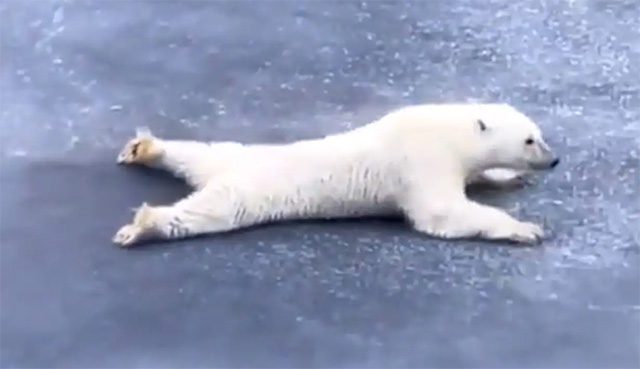To navigate through thin ice on the ocean surface, polar bears must use a special method of movement.
The sight of polar bears moving on ice floes or swimming in the frigid waters of the Arctic is familiar, but how do polar bears cross thin ice on the ocean without breaking it and risking a fall into the water? A clip currently circulating on social media provides the answer.
The clip, shared by Supriya Sahu, an employee of the Indian Forest Service, on her personal Twitter page, shows the moment a polar bear crosses thin ice on the ocean. Instead of walking as usual, this polar bear lays down and uses its front paws to pull its body across the ice.
“A way to move across thin ice without breaking it. A valuable lesson from the polar bear,” Supriya Sahu wrote on her Twitter page.
(Video: Twitter).
The clip quickly “went viral” on social media, with many users expressing their delight and admiration for the intelligence of the polar bear.
“When standing, the weight of the polar bear is concentrated on its two legs in one spot, but when it lays down on a flat surface, the weight is distributed over a larger area, equal to the size of the polar bear, which helps prevent the thin ice from breaking,” commented a Twitter user.
Many believe this is an essential survival skill that helps polar bears thrive in cold and harsh environments. Several users questioned whether humans could apply a similar technique to cross thin ice on water.
“Polar bears don’t need to take a physics class; Mother Nature has taught them the essentials for survival,” remarked another Twitter user.

This is how to move across thin ice without breaking it.
|
Polar bears are the largest land carnivores, residing in the areas surrounding the Arctic Ocean. An adult male polar bear can weigh between 350 to 540 kg, with some rare individuals exceeding 800 kg. Adult females are about half the size of males, weighing between 200 to 300 kg and standing 1.9 to 2.1 m tall, while males can reach heights of 2.4 to 2.6 m when standing on their hind legs. The largest polar bear ever recorded weighed 1,002 kg and stood 3.39 m tall on its hind legs. The primary diet of polar bears consists of seals. When food is scarce, polar bears may hunt dolphins, walruses, rodents, and even juvenile polar bears. Polar bears are highly skilled hunters, capable of swimming several kilometers out to sea to hunt. They are also adept at stalking prey on land. Climate change is impacting the habitat and hunting abilities of polar bears. The International Union for Conservation of Nature lists polar bears as a vulnerable species due to habitat loss and declining populations. |





















































